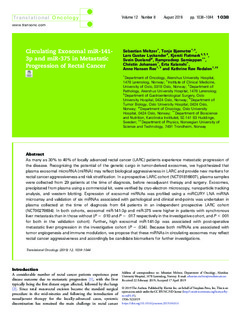| dc.contributor.author | Meltzer, Sebastian | |
| dc.contributor.author | Bjørnetrø, Tonje | |
| dc.contributor.author | Lyckander, Lars Gustav | |
| dc.contributor.author | Flatmark, Kjersti | |
| dc.contributor.author | Dueland, Svein | |
| dc.contributor.author | Samiappan, Rampradeep | |
| dc.contributor.author | Johansen, Christin | |
| dc.contributor.author | Kalanxhi, Ert | |
| dc.contributor.author | Ree, Anne Hansen | |
| dc.contributor.author | Redalen, Kathrine | |
| dc.date.accessioned | 2019-10-02T07:14:52Z | |
| dc.date.available | 2019-10-02T07:14:52Z | |
| dc.date.created | 2019-06-13T10:11:50Z | |
| dc.date.issued | 2019 | |
| dc.identifier.citation | Translational Oncology. 2019, 12 (8), 1038-1044. | nb_NO |
| dc.identifier.issn | 1944-7124 | |
| dc.identifier.uri | http://hdl.handle.net/11250/2619705 | |
| dc.description.abstract | As many as 30% to 40% of locally advanced rectal cancer (LARC) patients experience metastatic progression of the disease. Recognizing the potential of the genetic cargo in tumor-derived exosomes, we hypothesized that plasma exosomal microRNA (miRNA) may reflect biological aggressiveness in LARC and provide new markers for rectal cancer aggressiveness and risk stratification. In a prospective LARC cohort (NCT01816607), plasma samples were collected from 29 patients at the time of diagnosis, before neoadjuvant therapy and surgery. Exosomes, precipitated from plasma using a commercial kit, were verified by cryo-electron microscopy, nanoparticle tracking analysis, and western blotting. Expression of exosomal miRNAs was profiled using a miRCURY LNA miRNA microarray and validation of six miRNAs associated with pathological and clinical end-points was undertaken in plasma collected at the time of diagnosis from 64 patients in an independent prospective LARC cohort (NCT00278694). In both cohorts, exosomal miR-141-3p and miR-375 were higher in patients with synchronous liver metastasis than in those without (P = .010 and P = .017 respectively in the investigative cohort, and P < .001 for both in the validation cohort). Further, high exosomal miR-141-3p was associated with post-operative metastatic liver progression in the investigative cohort (P = .034). Because both miRNAs are associated with tumor angiogenesis and immune modulation, we propose that these miRNAs in circulating exosomes may reflect rectal cancer aggressiveness and accordingly be candidate biomarkers for further investigations. | nb_NO |
| dc.language.iso | eng | nb_NO |
| dc.publisher | Elsevier | nb_NO |
| dc.rights | Attribution-NonCommercial-NoDerivatives 4.0 Internasjonal | * |
| dc.rights.uri | http://creativecommons.org/licenses/by-nc-nd/4.0/deed.no | * |
| dc.title | Circulating Exosomal miR-141-3p and miR-375 in Metastatic Progression of Rectal Cancer | nb_NO |
| dc.type | Journal article | nb_NO |
| dc.type | Peer reviewed | nb_NO |
| dc.description.version | publishedVersion | nb_NO |
| dc.source.pagenumber | 1038-1044 | nb_NO |
| dc.source.volume | 12 | nb_NO |
| dc.source.journal | Translational Oncology | nb_NO |
| dc.source.issue | 8 | nb_NO |
| dc.identifier.doi | 10.1016/j.tranon.2019.04.014 | |
| dc.identifier.cristin | 1704550 | |
| dc.description.localcode | © 2019 The Authors. Published by Elsevier Inc. on behalf of Neoplasia Press, Inc. Open Access CC-BY-NC-ND | nb_NO |
| cristin.unitcode | 194,66,20,0 | |
| cristin.unitname | Institutt for fysikk | |
| cristin.ispublished | true | |
| cristin.fulltext | original | |
| cristin.qualitycode | 1 | |

